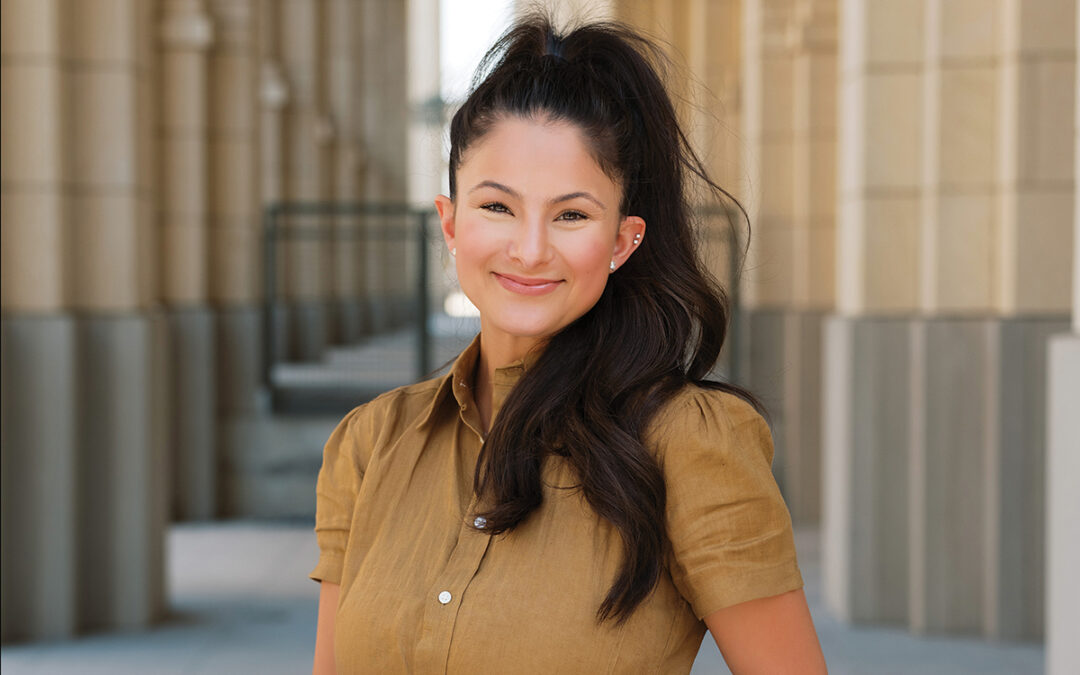Though she now spends eight-hour days in a chemistry laboratory, UTSA doctoral student Magaly Salinas didn’t grow up on the science-fair circuit. The first time she presented a poster at a conference was during her undergraduate years at the University of Texas — Pan American in Edinburg. As for elementary- or middle-school science, “I don’t even remember if I liked it or not,” she says, smiling and shaking her head. Always a good student while growing up in McAllen, Salinas was accepted into the South Texas High School for Health Professionals, a magnet school that was the only one of its kind in the Rio Grande Valley. There were some physicians on her father’s side of the family, and as she started high school, she says, “I was really interested in medicine.” Because she was thinking of specializing in pharmacology, she gravitated toward the school’s pharmacy program, where she could take a course in pharmacology followed by clinical rotations, while working toward certification as a pharmacy technician. During her senior year, she worked in a local Walgreen’s pharmacy to get a sense of what community pharmacists do and at Valley Baptist Hospital in Harlingen.
The experience, in two of the most common settings for pharmacy, made her unsure of her career choice. She was working in a pharmacy when she started college at Pan American, but would quit to concentrate on her studies as a chemistry major minoring in biology and Spanish. “It didn’t seem like what I wanted to do for the rest of my life,” Salinas says. “I wanted to know how medicines worked, not just dispense them. I wanted something more hands-on.” She found it in organic chemistry, which she took in her sophomore year. The notoriously hard course, which has caused many a would-be doctor or veterinarian to switch career goals, ignited her interest, and her professor, Narayan Bhat, asked her if she’d like to work in his lab. Salinas stayed on the job for her last two years in college, adding work as a teaching-assistant in chemistry and microbiology while leap-frogging through organic chemistry II, advanced organic chemistry and special topics in organic chemistry.
With her original goal in mind, Salinas applied to the University of Tennessee’s pharmacy school, one of a few programs that accept students who have completed all the course requirements before earning a bachelor’s degree. That summer, she went to Spain on an international-studies program, traveling around Europe on weekends and pondering her future. “When I came back, I was supposed to leave for Tennessee,” she says. Instead, she deferred her admission to pharmacy school and returned to Pan American, where she finished her undergraduate degree. “I waited a year and got that much more interested in research,” she says, so she decided to stay for a master’s degree in chemistry. After six years’ study of the subject, Salinas still hadn’t had enough schooling, although many of her friends had completed their education with a four-year degree. “I get it from my mom,” she says, with a smile. “When we want something, we don’t give up — we can’t give up!” Because Salinas wanted to stay close to her family, Professor Bhat steered her toward the relatively young Ph.D. program in chemistry at the University of Texas at San Antonio, where she is the recipient of a Minority Biomedical Research Support/Research Initiative for Scientific Enhancement Scholarship.
So far, the doctoral program has just four graduates; Salinas at present is the only woman at her level, though some female undergraduates and high-school summer-program students have worked in the same lab. Organic chemistry continues to fascinate her; having done some work on synthesizing lipopeptides that act as antimicrobials, she is enthusiastic about the possibilities in her field. It’s the chemistry of carbon compounds, she explains, adding that “There is such a wide variety of applications — pharmacology, vaccines, solar panels, polymers (chains of molecules that can form anything from DNA to industrial materials) and photochemistry (the study of interaction between light and molecules).” Environments in which to do research in chemistry are almost as varied, with settings in universities, industry, government and national labs. While Salinas understands that chemistry isn’t everybody’s cup of tea, she says, “I think my friends back home admire me because I don’t give up easily.” Presenting at conferences, including the Society for the Advancement of Chicanos and Native Americans in Science and at the Hispanic Engineering, Science and Technology Symposium, have given her confidence, but her highest achievement to date was getting to attend the 59th meeting of Nobel Laureates and Students held last summer in Lindau, Germany.
“Not many people know about (this) conference,” says Salinas. Nor did she, until Professor Negrete, in whose UTSA lab she works, forwarded an e-mail to her. It was a call for applications from students who wanted to attend this gathering of Nobel Prize-winning scientists, most of whom this year were chemists. Time before the application deadline was short, but Salinas didn’t let that stop her. To apply, she needed to get letters from her chemistry professor and administrators at UTSA, get her transcript sent, fill out a form and write an essay. About 600 students from all over the world attend; the 2009 group included only 72 from the United States. Besides Salinas, the doctoral and post-doctoral students represented some of this country’s most prestigious universities — Cal Tech, MIT, Yale, Columbia, Rice, Vanderbilt, the University of Michigan and other elite institutions. “People ask me how I got in, and I don’t know,” Salinas says. “It may have been my essay, where I said that not very many people where I come from are involved with or even aware of the scientific community. I would like to go back to the Valley and talk to students and science teachers about careers in research.”
The Nobel Laureates meeting was an inspiration to Salinas, who found the eminent scientists “very down-to-earth and interested in talking to students. They really wanted to hear what we had to say.” The Nobel winners made presentations about the areas in which they had distinguished themselves, but they also answered questions in panel discussions and talked about what they liked to do outside of work — “like canoeing in the Arctic,” Salinas says, smiling. Best of all were the eminent scientists’ admission that their experiments don’t always yield the expected results. “They talked about the disappointment you feel when things have been going well, but then you don’t get the results you thought you were going to get,” she says. “They’re not that different in that way (from graduate students).” Salinas plans to encourage other UTSA science grad students to attend next year’s Nobel Laureates meeting, where the theme will be the relationship between physics and medicine. She expects to complete her doctoral studies in about three years, teaching and doing her own research while working through the stages of topic paper, research proposal and dissertation.
Because her introduction to the world of international conferences has shown her that women and minorities remain underrepresented in scientific research, she hopes to find time and opportunities to get back to the Valley and share her views on her chosen career. “When (science) students there go on to school after college, it’s usually medical, pharmacy or dental school,” she says. “I’d like to use my experience to inspire others to engage in research.”
Magaly Salinas
Age: 25
Occupation: Doctoral student in chemistry, UTSA.
Personal: Single, close to her family in the Rio Grande Valley.
Why she’s a Role Model: Beginning a career in chemistry research, wants to spread the word about careers in science among youth in South Texas.
Her own role models: Parents Efrain and Marina Salinas, for pursuing their artistic talents — her father earned an MFA in photography, and her mother has taught art appreciation at the college level — and her chemistry professors Narayan Bhat, Ph.D., at the University of Texas — Pan American and George Negrete, Ph.D., at UTSA, for their support of minority students.
Best advice ever given: From her mother — “Do the best you can with whatever interest you have.”
Believes: “The key to success is motivation.”
People would be surprised that I…“Like to make jewelry. There are a couple of stores at home (in McAllen) where I buy semiprecious stones and make them into necklaces, bracelets and earrings, for myself and as gifts.”
Favorite relaxation strategies: Exercise — yoga and salsa dancing at UTSA’s recreation center.
What she’s reading: Doce Cuentos Peregrinos (translated as “Strange Pilgrims”), by Colombian novelist Gabriel Garcia Marquez, short stories about Latin Americans in Europe, given to her by her mother, “so I had to start reading it.”









0 Comments